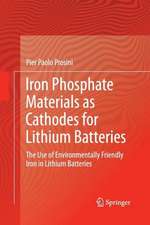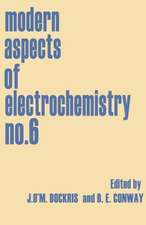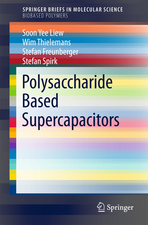Electrochemical Supercapacitors: Scientific Fundamentals and Technological Applications
Autor B. E. Conwayen Limba Engleză Paperback – 6 feb 2013
| Toate formatele și edițiile | Preț | Express |
|---|---|---|
| Paperback (1) | 2489.78 lei 6-8 săpt. | |
| Springer Us – 6 feb 2013 | 2489.78 lei 6-8 săpt. | |
| Hardback (1) | 2496.57 lei 6-8 săpt. | |
| Springer Us – 30 apr 1999 | 2496.57 lei 6-8 săpt. |
Preț: 2489.78 lei
Preț vechi: 3036.32 lei
-18% Nou
Puncte Express: 3735
Preț estimativ în valută:
476.48€ • 492.23$ • 396.55£
476.48€ • 492.23$ • 396.55£
Carte tipărită la comandă
Livrare economică 25 martie-08 aprilie
Preluare comenzi: 021 569.72.76
Specificații
ISBN-13: 9781475730609
ISBN-10: 1475730608
Pagini: 732
Ilustrații: XXX, 698 p.
Dimensiuni: 155 x 235 x 38 mm
Greutate: 1.01 kg
Ediția:Softcover reprint of the original 1st ed. 1999
Editura: Springer Us
Colecția Springer
Locul publicării:New York, NY, United States
ISBN-10: 1475730608
Pagini: 732
Ilustrații: XXX, 698 p.
Dimensiuni: 155 x 235 x 38 mm
Greutate: 1.01 kg
Ediția:Softcover reprint of the original 1st ed. 1999
Editura: Springer Us
Colecția Springer
Locul publicării:New York, NY, United States
Public țintă
ResearchCuprins
1 Introduction and Historical Perspective.- 2 Similarities and Differences between Supercapacitors and Batteries for Storing Electrical Energy.- 3 Energetics and Elements of the Kinetics of Electrode Processes.- 4 Elements of Electrostatics Involved in Treatment of Double Layers and Ions at Capacitor Electrode Interphases.- 5 Behavior of Dielectrics in Capacitors and Theories of Dielectric Polarization.- 6 The Double Layer at Capacitor Electrode Interfaces: Its Structure and Capacitance.- 7 Theoretical Treatment and Modeling of the Double Layer at Electrode Interfaces.- 8 Behavior of the Double Layer in Nonaqueous Electrolytes and Nonaqueous Electrolyte Capacitors.- 9 The Double Layer and Surface Functionalities at Carbon.- 10 Electrochemical Capacitors Based on Pseudocapacitance.- 11 The Electrochemical Behavior of Ruthenium Oxide (RuO2) as a Material for Electrochemical Capacitors.- 12 Capacitance Behavior of Films of Conducting, Electrochemically Reactive Polymers.- 13 The Electrolyte Factor in Supercapacitor Design and Performance: Conductivity, Ion Pairing and Solvation.- 14 Electrochemical Behavior at Porous Electrodes; Applications to Capacitors.- 15 Energy Density and Power Density of Electrical Energy Storage Devices.- 16 AC Impedance Behavior of Electrochemical Capacitors and Other Electrochemical Systems.- 17 Treatments of Impedance Behavior of Various Circuits and Modeling of Double-Layer Capacitor Frequency Response.- 18 Self-Discharge of Electrochemical Capacitors in Relation to that at Batteries.- 19 Practical Aspects of Preparation and Evaluation of Electrochemical Capacitors.- 20 Technology Development.- 21 Patent Survey.
Recenzii
`It is an excellent resource in that it provides a very comprehensive and in depth coverage of supercapacitor technology.'
IEEE Electrical Insulation Magazine, 18:2 (2002)
IEEE Electrical Insulation Magazine, 18:2 (2002)

























